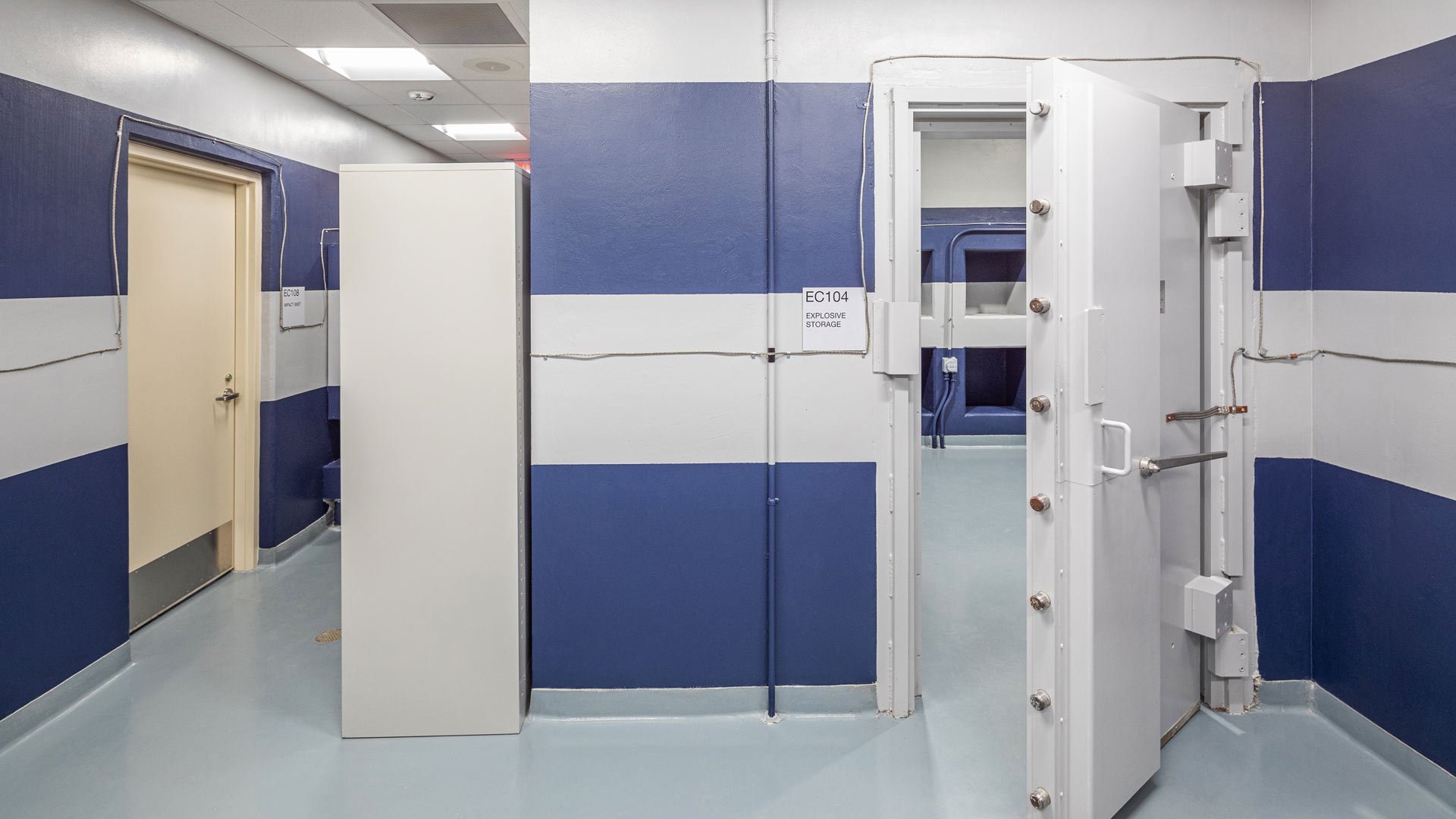Feature | September 30, 2025
Delivering the Boom: Safety Is Paramount in Developing Increasingly Powerful Bombs, Bullets and Missiles
The inherent hazards of developing the highly volatile energetic compounds needed by sophisticated military weapons systems are raising the stakes for safe design of labs and manufacturing facilities.
When it was dropped on a massive cave complex in Afghanistan in 2017, creating a mile-wide crater that obliterated an ISIS command center, the MOAB signaled a change in the future of warfare.
Packing a warhead that delivers the equivalent explosive power of more than 11 tons of TNT, the massive ordnance air blast (MOAB) — unofficially called the mother of all bombs — is today considered the most lethal nonnuclear ordnance in America’s military arsenal.
First developed in 2003 at Eglin Air Force Base for Operation Iraqi Freedom, the MOAB was intended mainly as a means to intimidate Saddam Hussein. Today, the MOAB is only one example of the ongoing research and development into nano-energetics technology that will form the backbone of progressively more lethal firepower needed by America’s military.
“The challenge today is to pack more and more punch in smaller and smaller weapons systems,” says Andy Mashek, principal and director of Department of Defense (DOD) projects at Burns & McDonnell. “All branches of the military are hard at work developing firepower that will deliver a bigger boom with greater precision and at lower cost.”
Moving In Lockstep
The MOAB was only a precursor of many other next-generation munitions that could determine how wars are fought in the future. The Air Force Research Laboratory (AFRL) at Eglin is now researching and developing ordnance utilizing nanoenergetics, a technology utilizing nanoparticles to achieve much faster reaction rates and higher energy releases.
Burns & McDonnell has played an integral role in planning and designing 17 new facilities on the 100-acre Advanced Munitions Technology Complex (AMTC) at Eglin in Okaloosa County, Florida.

AMTC Exterior
“The lethality of modern weaponry has progressed far beyond what the military had available just a few decades ago, but the energetics technology has not moved in lockstep with delivery systems,” Mashek says. “We’ve had fourth-generation weaponry deployed in fifth-generation aircraft. This R&D will get us to the point where we have sixth-gen weapons being loaded into sixth-gen aircraft.”
Thinking Through Every Scenario
Safety drives everything at the AMTC. Now in later phases of construction, this enormously complicated project broke new ground on a number of fronts, including an extreme focus on designing safety into every phase of the development process. New protective construction design concepts and configurations are among the templates used for precision-designed laboratory environments.
Military installations have long been well equipped to safely store and handle high explosives and munitions. However, research and development of progressively more lethal materials with nanoenergetics is the next frontier.
“Projects involving energetics are among the most demanding we can take on,” says Tyler Keel, an engineer-procure-construct (EPC) project manager at Burns & McDonnell specializing in defense manufacturing facilities. “Among other things, we have to understand the chemistry before we start. Once we understand the forces that will be generated during these intense explosions, we can then apply safety protocols needed to navigate a complex regulatory framework.”
A quantitative risk assessment (QRA), referred to on some sites as a process hazard analysis (PHA), is key to understanding risks from explosive and chemical materials. The data generated by this assessment is crucial in evaluating protective measures that inform design decisions.
Because of the more powerful explosive forces generated by nanoenergetics, the design concepts needed to protect technicians, researchers, scientists, contract workers and the general public often utilize heavier and thicker materials.
Design challenges at the AMTC facilities were exacerbated by the complexity introduced by relatively novel protection concepts subject to approval by the U.S. Department of Defense Explosives Safety Board (DDESB).
Protective design is achieved through one of three pathways defined by the DDESB in the Contractor’s Safety Manual for Ammunition and Explosives (DOD 4145.26). These can be generally described as follows:
- Avoidance: Using Quantity Distance (QD) arcs to place facilities at distances that would mitigate the exposure to hazards of blast forces and fragments.
- Prescriptive design: Relying on preapproved designs for safety of the workforce or the general public.
- Custom protective construction: Specific designs tailored to exact conditions and sites to mitigate the effects of blasts generated by various quantities of energetic materials.
The rigorous process spelled out under DOD 4145.26 requires contractors to understand how various amounts and properties of explosives would impact facilities upon detonation. These properties are identified during the QRA in a process that may involve blast modeling to determine how design could mitigate various levels of hazards.
Multilayer Protective Design
Because of the unique requirements for the explosives research complex at Eglin, the design concepts could not include conventional QD protection through separation of facilities. Moreover, other factors — like the need for acoustical/vibration protection for equipment, and necessity for personnel to move freely between buildings — required innovative protection strategies.
New protective configurations with a much greater degree of explosives containment through structural hardening were required so that blast effects could be contained within a facility rather than vented. Structural hardening also was designed to counter the effects of shock and gas loading, as well as other phenomena such as pressure leakage or thermal propagation through wall openings and conduit.

AMTC Interior
More than 30 pre-engineered steel blast doors and robust reinforced concrete walls, floors and roofs throughout were designed to protect personnel from detonations at various laboratories outfitted with specialized one-of-a-kind laboratory equipment. The design required acoustical analysis and the mitigation of vibration from low-flying, low-frequency-emitting aircraft. Additionally, various pieces of laboratory equipment required placement on heavy mass foundations to prevent vibrations being transmitted to adjacent laboratory spaces.
For facilities throughout the AMTC, a number of interrelated functions and processes require close proximity of personnel to potential blast zones. Protective designs required a range of hardening measures.
A Complex Designed for Safety and Precision
Each of the AMTC facilities is meticulously designed to facilitate research, testing, and fabrication of advanced explosives while maintaining the highest levels of safety. Layouts and protective configurations set new standards for high-explosives research and development, integrating structural hardening, controlled containment, and hazard mitigation strategies. Here’s a look at some of these facilities:
Revolutionary Ordnance Characterization Center (ROCC)
The research process begins at the ROCC, where scientists analyze the chemical composition and energetic properties of nanoscale materials. This facility is divided into two wings — one for inert materials and another for explosive compounds — to maintain a safe separation of low-risk and high-risk research activities. Here, researchers assess combustion characteristics and the stability of novel energetic materials, forming the foundation for subsequent explosives research.
Building for Initiation and Reactive Systems Science and Technology (BIRSST)
Once materials are characterized, they are tested in small-scale detonation chambers at BIRSST. These sealed steel pressure vessels allow scientists to safely examine the initiation properties of nanoenergetic compounds under controlled conditions. This facility provides critical early-stage insights into detonation mechanisms and potential sensitivities, winnowing out materials so that only stable and predictable compounds move forward in development.
Advanced Energetics Research Laboratory (AERL)
The AERL houses specialized laboratories that analyze the reactive properties of minute samples of explosives. Within this facility, researchers assess how nano-energetic materials interact with different environmental conditions, such as temperature and humidity, further refining their suitability for munitions applications. Due to the highly sensitive nature of these experiments, AERL incorporates reinforced containment structures and advanced safety monitoring systems.
Complex for Agile Processing of Energetics (CAPE)
As materials transition from research to fabrication, they are processed at CAPE. This facility consists of nine independent operations buildings, each dedicated to a specific task such as machining, milling or component assembly. To mitigate risk, each building operates remotely, controlled via a centralized monitoring station fortified by earthen barricades. This setup minimizes personnel exposure to accidental potential detonations while focusing on precise fabrication of explosive components.
Advanced Dynamics Chamber (ADC-50)
The culmination of explosives research and fabrication occurs at ADC-50, a hardened blast chamber designed to test full-scale explosive devices. Engineered to withstand detonations equivalent to 50 pounds of TNT, ADC-50 features concrete walls 3-feet thick, reinforced with two layers of 1-inch-thick steel plating. A 50-ton steel door mounted on a 50-ton frame completes the containment envelope, while high-speed cameras positioned behind 3-inch-thick protective glass capture detonation events in detail. This facility allows researchers to analyze blast dynamics, fragmentation patterns and explosive performance in a highly controlled environment.
Manufacturing Ammunition Safely
At the Lake City Army Ammunition Plant — a major DOD manufacturing facility in Independence, Missouri, that dates to World War II — safe design concepts are informing every stage of a 10-year renovation program supported by Burns & McDonnell. When complete, nearly every building on the 4,000-acre campus will have been either renovated, or demolished and rebuilt. The program’s centerpiece: massive new production facilities the size of several football fields.
The principles of safe design at Lake City are much the same as for a complex like the AMTC. Although the AMTC develops massively powerful individual explosives, the cumulative volume of explosive materials required for the manufacture of billions of rounds of ammunition at Lake City also pose risks.
The complex is slated for significant technology upgrades with a focus on automation, new computerized tracking and logistics for efficient materials movement.
With a large expanse of land available, conventional safety protocols of distancing will be in play for many of the new facilities. Still, some safe design concepts will be required to isolate and contain any disastrous effects of fires or explosions. For example, the team has conducted a test of the explosive forces that would be generated by detonations of various volumes of gunpowder within sealed containers. The data resulting from these tests are used to design protective walls and barriers and to select hardening materials for the protection of workers who will be stationed at facilities in close proximity to one another.
Baking the Cake
“Energetic processing involves many processes similar to baking a cake,” Keel says. “Ingredients are ground, mixed, cured, and trimmed. The raw materials and the finished packaged materials are less volatile. The processing in between is what requires extra care. Heat, humidity, vibration, impact and static electricity must be controlled. Proper design and planning accounts for these factors and more.”
Related Content
Project
Advanced Munitions Technology Complex
Case Study
Facility Control Systems Integration Unlocks Hidden Value for U.S. Marine Corps
Project
Trident Refit Facility (TRF) Dry Dock Repairs



.png)